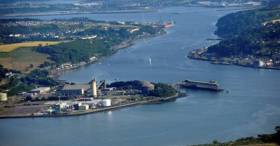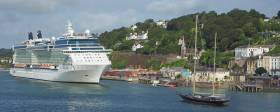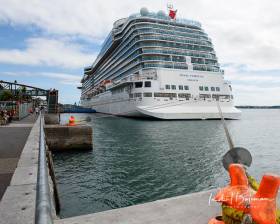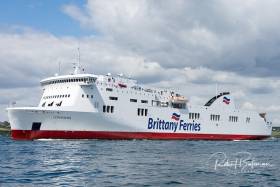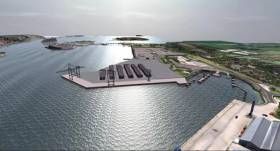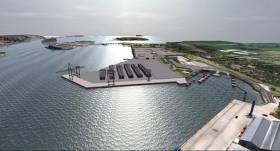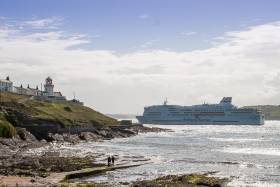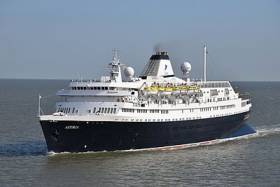Displaying items by tag: port of Cork
Port of Cork & MaREI Team Up to Deliver A Primary Schools Initiative For A Healthy Harbour
For the last 13 years the Port of Cork has delivered a schools initiative to 5th class primary schools across Cork City and County, with a particular focus on the harbour area. For the first time this year, the Port of Cork has teamed up with MaREI, the UCC research centre for marine and renewable energy based in Ringaskiddy, to deliver an educational initiative around marine litter.
Port of Cork and UCC team up to highlight the issue of marine litter through their primary school's initiative. Fact; Plastic bags are often mistaken for jellyfish and eaten by marine life.
Aoife Deane UCC and Sara Mackeown Port of Cork with Caomihe Mc Sweeney, Emily Rose and Caoimhe Ni Bheara of Scoil Bhríde Crosshaven Co Cork pictured with their 'Bloom of Plastic Jelly Fish'.
"Plastic bags are often mistaken for jellyfish and eaten by marine life"
Themed ‘Maintaining a Healthy Harbour’ the initiative aims to make school children aware of marine litter and the detrimental effects it can have on our oceans, harbour and shorelines. With the help of MaREI, classes are encouraged to collect and use marine litter and recycled items to create a 3D art project that will make people stop and think. Researchers estimate that over 10 million tonnes of litter ends up in the world’s oceans each year and 1 million seabirds and 100,000 marine mammals (seals, whales, dolphins) die every year because of marine litter through entanglement or ingestion. There is a growing public awareness of the issue, and with almost half of all marine litter being made up of just 10 types of single-use plastic items, we can take steps to tackle the problem.
Port of Cork Chief Executive Mr Brendan Keating said: ‘Our schools Initiative has gone from strength to strength and this year are we delighted to partner with MaREI. They have great expertise in this area and their guidance in shaping the theme has been invaluable.’
He continued: ‘The issue of marine litter is apparent in all harbours and it is so important that school children recognise the impacts marine litter can have on a harbour both in and out of the water. As well as being educational, our initiative is fun and children have a great opportunity to be creative. I would strongly encourage primary schools in Cork to take part in this initiative.’
MaREI’s Communications and Public Engagement Manager, Aoife Deane, commented: ‘We are delighted to be collaborating with Port of Cork on their long established outreach initiative highlighting the value of our harbour. The ‘Healthy Harbour’ theme encourages students to think about the sources and impact of marine litter, and our reliance on single use plastics. And the exhibition of their artwork is an opportunity to highlight these issues to a wider audience.’
Each year the Port of Cork has over 30 schools from both Cork City and county participating in the Schools Initiative and they hope that this year will be no different.
All 5th classes who take part in the Port of Cork Schools Initiative will be treated to a boat trip around Cork harbour, compliments of the Port of Cork and each class will also receive a certificate of participation. The overall ‘Best Project’ will receive a tour on board one of the many luxurious cruise liners visiting Cork during the summer of 2019.
All submitted projects will go on public display in the Cobh Maritime Development building before the winner is announced in May 2019. Closing date for entries is Friday 12th April 2019.
If you would like more information on the Port of Cork Schools Initiative or would like to register your school, please contact Sara Mackeown, Port of Cork, email [email protected] or call 021 4625375.
Plans In Cork Harbour to Start Marino Point Redevelopment
#PortofCork - Chairman of the Port of Cork, John Mullins, hopes that activity can return to the long-idle Marino Point within two years, bringing valuable jobs to the area.
As The Evening Echo writes, since the former IFI plant closed, in 2002, with the loss of 220 jobs, the jetty (except for a recent Naval visitor) and other faclities have lain idle for years.
The Port of Cork led a consortium to buy it and, since the deal was finalised, in 2017, there has been significant interest in the project.
“We are working on the new masterplan for Marino Point,” Mr Mullins said. “We have parcels of land there and various people looking at them and we will be presenting a masterplan to Cork County Council of various tenants that intend to go in there.”
The Marino Point jetty is located in ten metres of water, enabling large ships to dock there, and the plan is for it to be used as a bulk terminal for products like agrifeed and fertiliser.
More on the story can be read here.
Cruiseships Record of 103 Call Visits to Cork Harbour in 2019
#CruiseLiners - Cruiseliners are to set a record with 103 calls booked to visit Cork next year, reports BreakingNews.ie, including several which will dock in the port for the first time.
New ships such as Celebrity Cruises MV Celebrity Reflection and Ocean Cruises MV Scenic Eclipse, billed as a contender for the world's most luxurious cruise ship, will make their maiden visit to the deep water quay in Cobh, along with Holland American Lines MS Nieuw Statendam.
With one more cruise ship left to dock this year (Afloat identified as CMV's Marco Polo), the Port of Cork’s 2018 cruise season is drawing to a close.
In total 92 cruise ships will have visited in 2018, which represents the most significant cruise season ever for the Port of Cork.
More than 157,000 passengers and 69,000 crew will have stepped ashore, boosting the local economy by an estimated €12m.
For further reading on the cruise-sector calling to Cork Harbour, click here.
Cruise Passengers Boost Cork’s Economy by €12 Million as 2018 Cruise Season Draws to a Close
With one more cruise ship left to visit in December, the Port of Cork’s 2018 cruise season is drawing to a close. A total of 92 cruise ships will have visited in 2018, the most significant cruise season ever for the Port of Cork; and with over 157,000 passengers and 69,000 crews stepping ashore this summer, the local economy gained over €12 Million.
The increased cruise calls to Cork are indicative of the wider global cruise business which has seen huge growth. In 2018 it is estimated that 27.2 million people will have taken a cruise on over 450 cruise ships worldwide.
With the global cruise ship order book for new build contracts reaching 113 ships between now and 2027, Cork cruise business is set to grow further in the coming years and the Port of Cork is eager to attract these new ships.
Mr Brendan Keating, Port of Cork Chief Executive said: ‘Even though our cruise business has grown 30% in the last year, the biggest beneficiary is the region with up to €12 million injected into the local economy over the summer cruise season. This is a significant boost which we are delighted to facilitate. In 2019 we anticipate over 100 cruise calls to Cork and realistically this is how we expect the cruise business pace to continue.’
In October, the Port of Cork visited all the major cruise lines calling to Cork and feedback from the companies was very positive in terms of their passenger experiences when visiting Cork. Currently all cruise operations are handled in Cobh, Ireland’s only dedicated cruise berth, however, with the continued growth in calls, the Port of Cork is now keen to explore the option of a second cruise berth in Cobh.
In that regard, the Port of Cork last week launched their ‘Expressions of Interest’ to the market inviting submissions from potentially interested parties to develop and/or operate a new cruise berth at Lynch’s Quay Cobh.
Mr Conor Mowlds, Port of Cork Chief Commercial Officer said: ‘By launching the Expressions of Interest we will see if there is an appetite in the market to develop a new cruise berth in Cobh. From the Port’s perspective, we know this business is growing and we want to have every possible option ready to capitalise on this business.’
Port of Cork & Bantry Bay Port Company Achieve a Combined Turnover of €31.5m in 2017
The Port of Cork Company and Bantry Bay Port Company today announced their combined turnover for 2017, showing a positive increase compared to 2016. Consolidated Turnover for the year 2017 amounted to €31.5 million (incl. €0.54 million Bantry Turnover) up from €29.6 million (incl. €0.21 million Bantry Turnover) in 2016.
Consolidated Profit on ordinary activities before taxation amounted to €5.9 million compared to €4.1 million in 2016, an increase of €1.8 million due to improved trading activity and an improved return in Bantry. Profit after tax amounted to €5 million in 2017 (2016: €3.3 million).
In 2017, Port of Cork and Bantry trade traffic totalled 10.3 million tonnes compared to 9.5 million tonnes in 2016 which represents an increase of 814,000 tonnes or 8.6%. Total Oil throughput in 2017 through Bantry Bay and Whitegate oil Refinery amounted to 6.4 million tonnes up from 5.7 million tonnes in 2016, an increase of 11.4%. Total Container Traffic was 217,763 TEU, an increase of 4% on 2016 TEU’s.
Commenting on the 2017 annual results, Port of Cork Chairman John Mullins said: ‘our annual results for 2017 are very positive and the increase in total traffic is a reflection of these figures. I am also pleased to say that in 2017 the Port of Cork Company approved a dividend payment to the Exchequer of €693,065, an increase of 3% on 2016. We are committed to supporting the shareholder and will continue to pay a yearly dividend while also pursuing our capital strategic development plan.’
In 2017 both ports achieved a number of significant company successes, most notably the Port of Cork who received full planning permission for the altered first phase of the Ringaskiddy Port Development project.
Chief Executive Brendan Keating said: ‘Overall we are very encouraged by the increase in turnover compared with 2016. In 2017 the port agreed a funding structure for the Ringaskiddy Port Redevelopment with the EIB, AIB and ISIF (the Ireland Strategic Investment Fund). This €80 million port redevelopment will deliver more efficient container handling facilities thus securing ‘Cork Container Terminal’ as an international gateway for trade well into the future.’
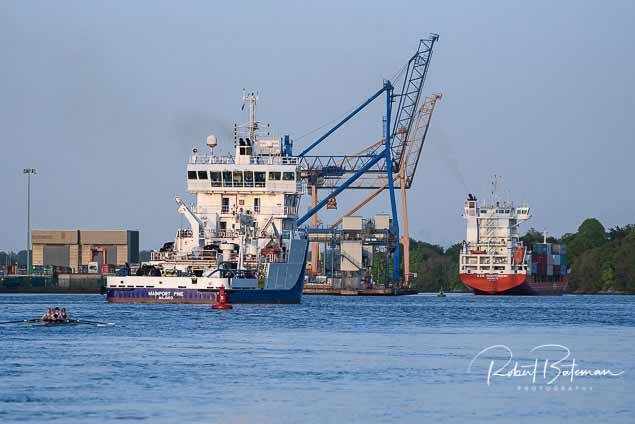 Tivoli Docks are moving to Ringaskiddy as part of Port of Cork plans Photo: Bob Bateman
Tivoli Docks are moving to Ringaskiddy as part of Port of Cork plans Photo: Bob Bateman
He continued: ‘This redevelopment will replace the existing container terminal at Tivoli and the transfer of Port related activities from the city and Tivoli will create a real opportunity for Cork Dockland sites to be redeveloped in the near future.’
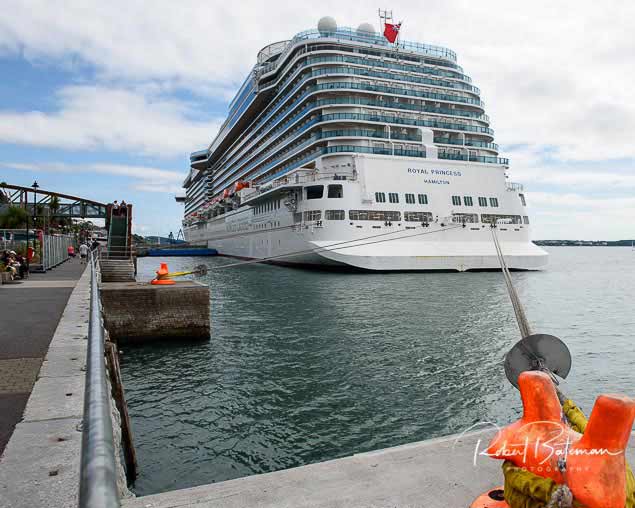 The Cruise Liner Royal Princess berthed at Cobh in Cork Harbour last Sunday Photo: Bob Bateman
The Cruise Liner Royal Princess berthed at Cobh in Cork Harbour last Sunday Photo: Bob Bateman
The cruise business has gone from strength to strength with 68 cruise liners calling to Cork and seven calling to Bantry in 2017. These cruise calls brought over 142,000 passengers and crew to the region, providing a substantial contribution to the local economy. In 2018, 96 cruise liners will visit the Port of Cork, a 30% increase on 2017 calls.
Another notable achievement in 2017 was the progress made on the establishment of a new ROPax service to Northern Spain and France culminating in the announcement by Brittany Ferries of a new twice weekly service to Santander, Spain and year round service to Roscoff, France. This new service, the first direct service from Ireland to Spain, will offer the option for freight carriers and passengers to bypass the UK and French land-bridge to Spain as Brexit uncertainty continues.
In Bantry, Phase 1 of the Bantry Inner Harbour Development costing in the region of €9million was completed and the official opening ceremony of the Bantry Marina development took place in August 2017.
Tender Sums Mistake Halts Cork’s Port Move Plans
#PortOfCork - The Port of Cork’s relocation to Ringaskiddy could be delayed by a ‘mistake’ in a tender for the civil engineering part of the the €82 million project, as the Irish Independent reports.
BAM Civil Ltd says it made a “significant mistake” in its sums for the €46.4 million tender that is short some €12 million for overheads.
Commercial Court proceedings are now ongoing, with the Port of Cork Company seeking that work commence as per the terms of the contract, as well as the provision of tax-clearance certificates and evidence of insurance among other orders. The Irish Independent has more on the story HERE.
The container terminal development at Ringaskiddy — relocated to Cork Harbour from the city centre at Tivoli docks — was launched yesterday as reported on Afloat.ie.
The Port of Cork marked a major milestone for the company today with the launch of the new Cork Container Terminal development in Ringaskiddy, as Afloat.ie first reported in 2015.
The Cork Container Terminal will initially offer a 360 metre quay with 13 metre depth alongside and will enable larger ships to berth in Ringaskiddy. The development also includes the construction of a 13.5 hectare terminal and associated buildings as well as two ship to shore gantry cranes and container handling equipment.
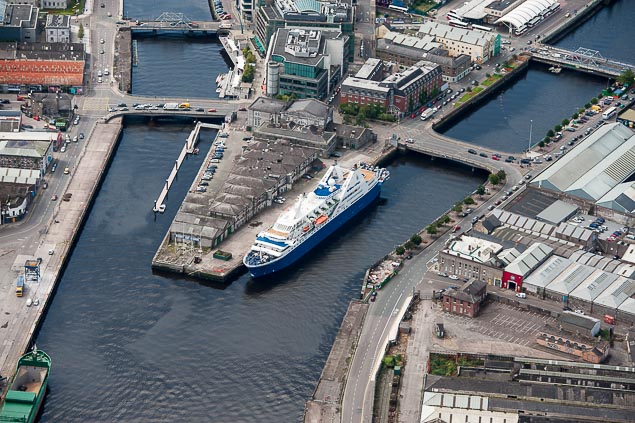 A ship berthed upriver at the Port of Cork at Custom House Quay Photo: Bob Bateman
A ship berthed upriver at the Port of Cork at Custom House Quay Photo: Bob Bateman
The requirement for the development of new container handling facilities at Ringaskiddy was identified in the Port of Cork’s Strategic Development plan in 2010. It will accommodate current and future container shipping which can be serviced by modern and efficient cargo handling equipment with innovative terminal operating and vehicle booking systems. The Port of Cork anticipates that Cork Container Terminal will become operational by 2020.
Chairman of the Port of Cork, Mr John Mullins said: “The Port of Cork’s redevelopment at Ringaskiddy is a key growth enabler for both Cork city and region as well as the national economy and will enable the Port to deliver more efficient container handling facilities, replacing the existing container terminal at Tivoli, and securing the Cork Container Terminal as an international gateway for trade well into the future.
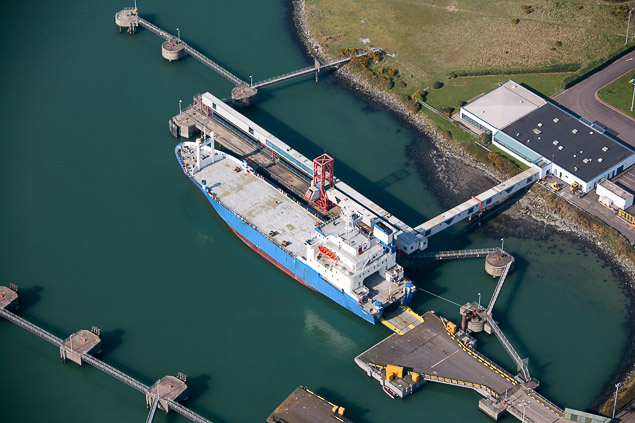 The existing deepwater berth at Ringaskiddy is being developed Photo: Bob Bateman
The existing deepwater berth at Ringaskiddy is being developed Photo: Bob Bateman
He continued: “The transfer of Port-related activities from the city and Tivoli will create a real opportunity for Cork Dockland sites to be redeveloped in the near future.”
This state of the art facility is the most significant single investment in marine infrastructure and superstructure in the history of the Port of Cork Company. Representing an investment of €80 million, the development is being funded by the Port through an innovative and award-winning financing structure comprising Allied Irish Banks, p.l.c, the European Investment Bank, and the Ireland Strategic Investment Fund (ISIF), and also by including European Union Connecting Europe Facility funds and self-finance.
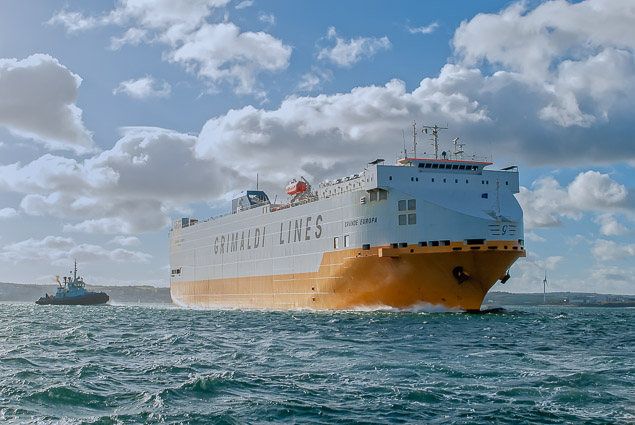 A massive Car Carrier arrives into Cork Harbour Photo: Bob Bateman
A massive Car Carrier arrives into Cork Harbour Photo: Bob Bateman
The Port of Cork awarded the development’s civil engineering contract to BAM Civil Ltd., part of the multi-national construction group, Royal BAM Group of the Netherlands.
Port of Cork Chief Executive, Brendan Keating said: “This development will secure the future for the Port of Cork, and ensure the trade gains are translated into significant economic benefits for the people of Cork and the Munster region, as well as the national economy. As part of this redevelopment the Port of Cork will deliver a public marine leisure amenity at Paddy’s Point and has also committed a €1 million community gain fund for the Ringaskiddy area for the development of an enhanced public realm scheme. We look forward to supporting the community and Cork County Council as they prepare and implement the scheme.”
Donal Murphy, Head of Infrastructure and Credit Investments at ISIF said: “This is an important investment for ISIF that demonstrates our commitment to investing in key infrastructure throughout Ireland on a commercial basis. It is the latest investment from our Connectivity Fund, which was established with proceeds from the sale of the State’s shareholding in Aer Lingus.
ISIF is using its ability to act as a long-term provider of capital to back the Port of Cork with flexible funding that is tailored to its specific needs. We expect this investment will underpin significant economic activity in the southern region. It will also enhance Ireland’s transport and supply chain links with major EU markets and help Irish exporters to access these markets post-Brexit.”
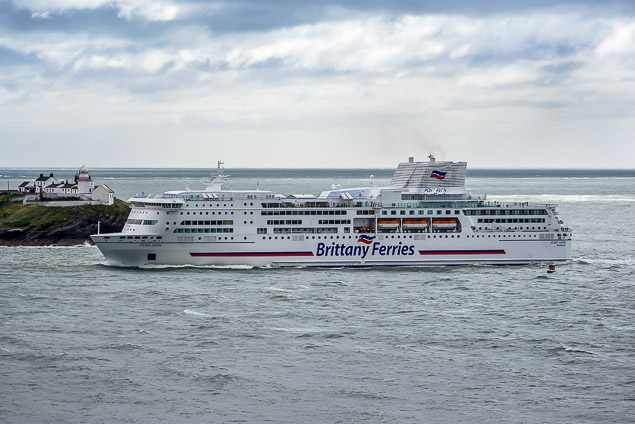 The Brittany Ferries flagship Pont Aven is a weekly runner into Ringaskiddy Photo: Bob Bateman
The Brittany Ferries flagship Pont Aven is a weekly runner into Ringaskiddy Photo: Bob Bateman
Conor Morgan, AIB Corporate Banking said “As the Port of Cork’s long-term relationship bank, AIB Corporate Banking is delighted to provide this financing for the Port of Cork to back their strategic development at Ringaskiddy Port. Following a funding process of over two years, an innovative transaction structure was put in place involving senior debt from AIB and EIB and junior debt from ISIF. As a key infrastructure deal supporting the growth of the Irish economy, the project increases future capacity at the port and brings major strategic value to the city of Cork and the Munster region.”
Andrew McDowell, European Investment Bank Vice President said “The redevelopment of Ringaskiddy will transform links between Ireland, Europe and the world, support exports by Irish business and create a world-class maritime logistics hub. The European Investment Bank is pleased to provide a EUR 30 million 18 year long-term loan alongside financing from leading Irish institutions for this crucial investment for Cork and Ireland. EIB support reflects the economic benefits and urban redevelopment to be unlocked in the coming years and the importance of ensuring alternative transport routes given export growth and ongoing uncertainties related to Brexit.”
In May 1978 Brittany Ferries launched their Cork-Roscoff ferry route from Cork City Quays with their flagship MV ‘Armorique’. At the time, all ferries departing Cork used the passenger terminal at Tivoli, before being transferred downriver to the dedicated Ringaskiddy Ferry Terminal which opened in 1982. Since then the passenger and freight route linking Ireland and France has gone from strength to strength and today the Port of Cork acknowledged this service by wishing Brittany Ferries a Happy 40th Anniversary linking the two countries.
Port of Cork Chairman, John Mullins said: ‘It is with great pleasure that today we wish our long-term customer, Brittany Ferries, a very happy 40th anniversary linking Ireland and France. This company has shown true dedication in providing a reliable and attractive ferry service for both passengers and freight. On behalf of the Port of Cork I would like to congratulate Brittany Ferries on the last the 40 years’ service and wish them every success for the next 40 years.’
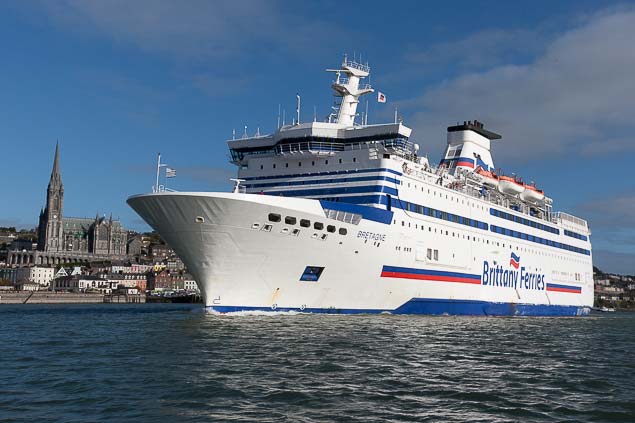 Britanny Ferries Bretagne off Cobh in Cork Harbour Photo: Bob Bateman
Britanny Ferries Bretagne off Cobh in Cork Harbour Photo: Bob Bateman
Over the last 40 years Brittany Ferries have become the market leader on the Western Channel for passengers and freight and in 2018 this commitment was further endorsed when Brittany Ferries announced the first ever ferry service linking Ireland and Spain, with the new Ro-Pax twice-weekly service from Cork to Santander. As well as serving Cork to Santander, this route also delivers an additional weekly return-sailing from Cork to Roscoff.
The new Ro-Pax ferry service was welcomed by the Port of Cork which has brought an increase in Spanish tourism to Cork and provides a very useful connection for exporting freight from Ireland to mainland Europe. This new service, the first direct service from Ireland to Spain, will offer the option for freight carriers and passengers to bypass the UK and French land-bridge to Spain as Brexit uncertainty continues. The Port of Cork hinterland is the key primary pharma, agriculture and food & drink output region in the country. This more efficient supply chain will offer freight customers a direct route to market enabling them to get their produce to market quicker than if they travel through traditional ports.
In 2017, Brittany Ferries carried more than 87,000 passengers, which was an increase of 4% on the previous season and contributing to the national economy. While France continues to be a popular travel destination for Irish travellers, the number of French people visiting Ireland showed no signs of waning as nearly 45,000 availed of the route, representing 52% of all passengers carried.
30% Increase in Port of Cork Cruise Business in 2018
MV Astoria arrived into Cobh today, the first of 94 cruise liners to visit the Port of Cork in 2018, a 30% increase on 2017 calls. The Port of Cork anticipates with 94 cruise calls the total passenger numbers to be 188,844 and 80,000 crew.
Up to eight cruise liners will make their maiden calls to Cork, including Disney Cruise Lines ‘MV Disney Magic’ in September and the largest of the MSC Cruise Lines fleet, MSC Meraviglia carrying a maximum of 4,500 passengers. Royal Caribbean’s MV Royal Princess will call ten times in 2018.
In 2017 the Port of Cork carried out cruise research on both passengers and crew arriving into Cobh and Ringaskiddy. The aim of the research was to get a sense of passengers shore excursions experiences and to determine any areas are in need of improvement. According to the research results many passengers who take the pre-booked shore excursions reported high experiences, while the ‘independent’ passengers seem to be looking for alternative more active experiences in both the City and the County.
The results of the cruise research also highlighted an increase in passenger and crew spend. On average, cruise ship passengers spend €81 during their time in Cork; with 42% of this money being spent on shopping, 32% on excursion travel and 17% on food and drink. Typically crew spend approximately €29, with most of the money being spent on food and drink and/or shopping.
Commercial Manager Captain Michael McCarthy said: ‘We have seen a massive surge in cruise calls for 2018 with a 30% increase in calls. These calls will bring outstanding economic growth to Cork City and County between March and September, with over 180,000 passengers stepping ashore and 80,000 crew.’
He continued: ‘We are absolutely delighted with the growth in the cruise sector and so far we are seeing a high volume of calls for 2019 also. It’s very encouraging to see cruise lines bringing their newest vessels to Cork on maiden calls and choosing Cobh as part of their cruising route.’
As well as Cork the Port of Cork also operates Bantry Bay Port Company which will see ten cruise liners calling to the West Cork area this summer. Bantry Harbour and Glengarriff can accommodate the smaller boutique cruise liners whose passengers tend to look for active expedition cruises. In 2017 just five liners called West Cork, showing a 50% increase in 2018 calls.
Mullins Reappointed as Chairman of the Port of Cork
The Minister for Transport, Tourism and Sport, Mr. Shane Ross TD on the re-appointment of Mr. John Mullins as Chairman of the Port of Cork.
Mr. John Mullins said: ‘I am grateful of the trust placed in me by Minister Shane Ross on my reappointment as Chairman of the Port of Cork. The next there years promise to be the most transformational period for the Port of Cork in its history. The transition from a River Port to a Sea Port will be substantially completed over this period. Land made available by this transition will provide Cork City with the ability to address an exciting commercial and municipal future by enabling the development of the Docklands and Tivoli.’
Welcoming the re-appointment, Mr Brendan Keating, Port of Cork Chief Executive said: ‘On behalf of the Port Management and Board of Directors, I would like to congratulate Mr. Mullins on his re-appointment as Chairman. Having this continuity on the board is vital as the Port of Cork enters a critical stage of the Ringaskiddy Port Redevelopment.’
Mr. Mullins will continue as Chairman of the Port of Cork for a further three years.



























